You’ve identified a motor – or quite possibly a shortlist of air motors – that is capable of fulfilling the basic function required in terms of the power/torque/speed equation. Now you need to consider other factors that could impact the actual on-the- job performance. As they say, the devil is in the detail, so get that right and you’re all set for a long and happy relationship with your motor!
Here are various factors that could affect your choice of air motors depending on your specific intended use for the motor and your preferences:
The starting torque is the torque level at which the motor is able to power up – in other words, the maximum torque that can be applied to a motor when it is not running without being too great for the motor to start up. This can be critical when handling heavier loads. If you imagine a crane moving a heavy load, the starting torque is the level at which the crane’s motor can go from zero to lift.
Looking for a starting torque : Make sure that air motor will start with a giver load
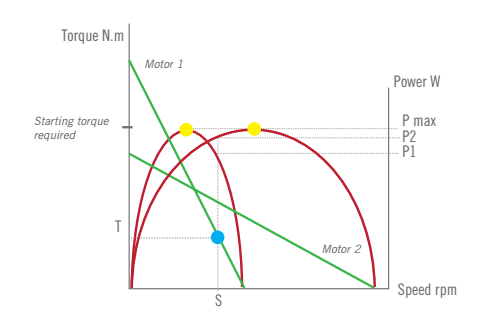
P2 > P1 motor 2 seems to be the best choice
Motor 2 cannot provide the required starting torque
> Motor 1 is the best choice
The stall torque is the torque level at which the motor will shut down, or stall. Once the torque level becomes higher than the motor can handle, the motor will automatically power down. It is important to know the stall torque because you may need a motor with a higher stall torque for your use (or the motor will continually fail), or conversely, it may be important that your motor cuts out before reaching a certain level, in order to protect your machinery for example. (NB: use a torque limiter if you want the motor to stop at a precise limit.)
Looking for a maximum torque : make sure that air motor will stop a given load
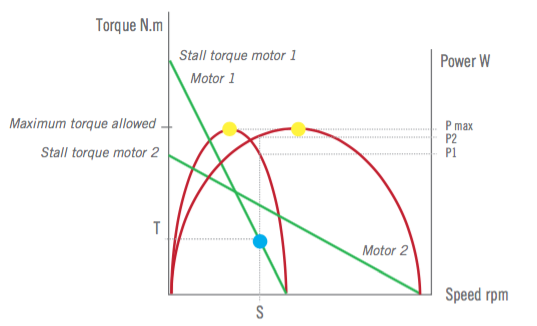
Motor 1 may reach a higher torque than the maximum allowed.
Motor 2 will stall before reaching the maximum torque allowed
> Motor 2 is the best choice
Use the torque limiter if you want a precise limit
Looking for a minimum torque : make sure that air motor will reach a given load
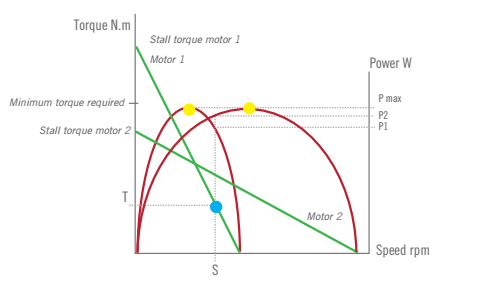
Motor 1 can reach the torque required.
Motor 2 will stall before reaching the torque required
> Motor 1 is the best choice

If you want to optimise energy efficiency in your operations, then you want your motor to work at maximum power. In this case, look for a motor with an optimal working point that is the closest to your working point. Working at maximum power also enables you to choose the smallest motor capable of fulfilling the function required, which can be advantageous if operating in a confined space, as well as costing less money.
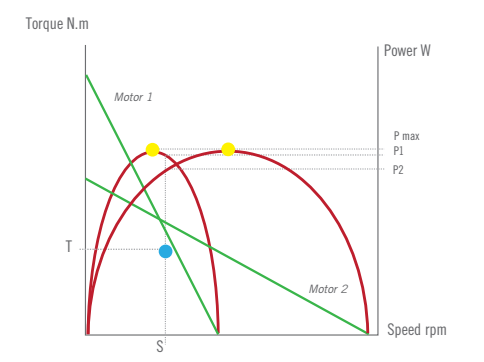
> Motor 1 is the best choice
Looking for efficiency :
For some functions, it is important to have a power reserve in case the torque level increases or changes. With some applications, there may occasionally be a need to increase the load and the motor needs to be able to handle the increased torque without unduly slowing the overall process. In others, the load may fluctuate regularly and you need a power reserve to maintain a steady power.
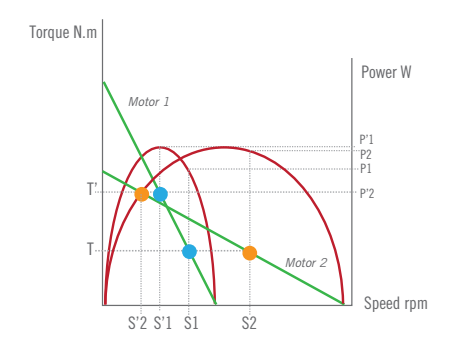
For the initial torque T, P2 > P1 and motor 2 seems to be the best choice
When the torque increases from T to T’
With motor 1, the speed reduces from S1 to S’1 and the power increases from P1 to P’1
With motor 2, the speed reduces from S2 to S’2 and the power decreases from P2 to P’2
P’1 > P1
P’2 < P2
P’1 > P’2
Motor 1 is the best choice
Looking for a power reserve :
In certain circumstances, you might not have easy access to compressed air and the supply may therefore be limited. In this case, it could be that reducing the amount of air consumed becomes a priority.
Air consumption level is dictated by the rotation speed, with maximum consumption at free speed.
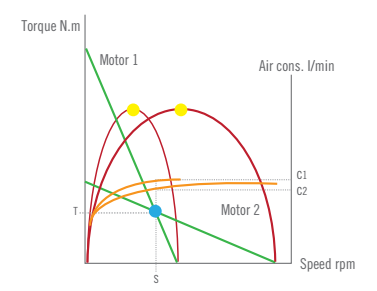
For the given output speed and torque, the pneumatic part of motor 1 will run at a fastest speed than motor 2, consuming therefore more air.
> Motor 2 is the best choice
Looking for a reduced air consumption :
If you want to know more about more air solutions, please download our guide :

+ 33 (0) 4 75 40 27 15
sales@modec.fr
ZI Sirius Quatre
80, allée René Higonnet
26760 Beaumont-lès-Valence, FRANCE
© Tous droits réservés - Modec - Création : ARKOD